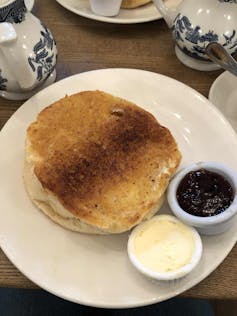Jane Austen’s Paper Trail is a podcast from The Conversation celebrating 250 years since Jane Austen’s birth. In each episode, we’ll be investigating a different aspect of Austen’s personality by interrogating one of her novels with leading Austen researchers. Along the way we’ll visit locations important to Austen to uncover a particular aspect of her life and the times she lived in.
As well as a sharp eye and an even sharper wit, Jane Austen was also, at times, in possession of a sharp tongue.
The burning of most of Austen’s letters by her sister Cassandra after her death has long been considered an unforgiveable act of literary vandalism. We know from her novels and the letters that did survive, that Austen did not suffer fools. She mercilessly exposed idiots, sycophants and narcissists to most enjoyable and satisfying effect. These letters probably contained evidence of Austen at her most shocking, for even the loftiest minds cannot fail to be entertained by a delicious piece of neighbourly tittle-tattle.
At a time when women were still considered chattels with very little agency, two pastimes could provide great relief from the interminable boredom that threatened to thwart an agile young mind: walking and gossip. Preferably at the same time. Or at the very least over a nice cup of tea sipped daintily from bone china in the presence of buns as large as one’s face.

Gossip in the world of Jane Austen served several important functions: entertainment, intel, communication, miscommunication and control. As reputations were fiercely guarded, one piece of misdirected or unfounded gossip could leave a young woman’s honour in tatters. Deployed strategically, that was often precisely the point.
Gossip is a subject which Austen explores in all these forms in her first novel, Sense and Sensibility. Published in 1811, it follows the lives of two very different sisters, Elinor and Marianne Dashwood, as they navigate the vagaries of love and romance in reduced circumstances after the death of their father.
In the first episode of Jane Austen’s Paper Trail, Jane Wright visits Sally Lunn’s tearoom in Bath – where Austen herself often took tea – with Andrew McInnes of Edge Hill University, whose work examines the notion of the “Romantic ridiculous”.
Over plates of large brioche buns smothered with cinnamon butter, McInnes is here to help us understand Austen’s relationship with gossip. “Taking tea was one of the main ways women could get together and talk privately,” he explains. “And though Jane had a wide circle of friends and acquaintances, she probably came here most with [her sister] Cassandra.”

In Sense and Sensibility, there’s a sense that Austen both despised and enjoyed gossip. “There is undoubtedly a double edge to Jane’s writing,” says McInnes, “in that she does say some of these gossiping characters are ridiculous, silly and pathetic. But a lot of the fun and amusement and comedy comes from those same characters gossiping and spreading the news and driving the plot forward.”
Later on in the episode, Anna Walker take a deeper dive into the subject of gossip in Sense and Sensibility with two more Austen experts. Lucy Thompson is a lecturer in 19th-century literature at Aberystwyth University, whose work examines how surveillance played out during the Austen period. Joining her around the table is Katie Halsey, professor of English studies at the University of Stirling, where she researches Jane Austen and the history of reading.
As Halsey explains, there are “lots of different roles for gossip in the book … Sometimes Jane uses it to suggest that a character a bad person. Sometimes it’s used to carry the plot. Sometimes it’s used to misdirect and point us in the wrong direction. It’s very often used for comic effect.”
But Halsey also sees an undeniable “dark edge” to the gossip in the novel. Being the subject of gossip, as Austen well knew, could “damage your marital prospects and also leave you ostracised from society,” Thompson explains.
Listen to episode 1 of Jane Austen’s Paper Trail wherever you get your podcasts. If you’re craving more Austen, check out our Jane Austen 250 page for more expert articles celebrating the anniversary.
Disclosure statement: Andrew McInnes, Lucy Thompson and Katie Halsey do not work for, consult, own shares in or receive funding from any company or organisation that would benefit from this article, and have disclosed no relevant affiliations beyond their academic appointment.
Jane Austen’s Paper Trail is hosted by Anna Walker with reporting from Jane Wright and Naomi Joseph. Senior producer and sound designer is Eloise Stevens and the executive producer is Gemma Ware. Artwork by Alice Mason and Naomi Joseph.
Listen to The Conversation Weekly via any of the apps listed above, download it directly via our RSS feed or find out how else to listen here.
This article was originally published on The Conversation. Read the original article.







